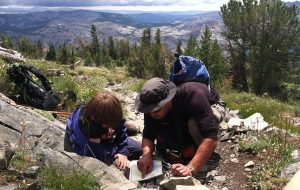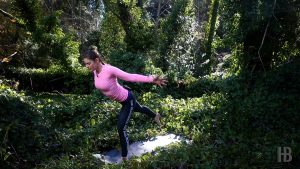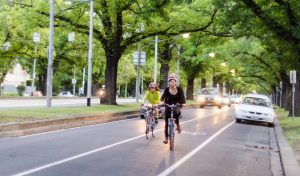4
“Executive functions (EFs) are critical for success in school, on the job, and in life. EFs suffer if you are lonely, sad, stressed, or not physically fit” (Diamond, 2014).

The next level of increasing PEBs revolves around physical movement–moving from the mental to the physical. Movement plays an important role in determining pro-environmental behavior (PEB) and the continuation of PEBs. Movement and the concept of Executive Function (EF) are directly connected, with EF moderating behavior, leading to changes in self-concept. In this way, EF, self-identity, and movement are all important in building goals and doing PEBs.
So, what are EFs? Executive function is composed of “working memory, inhibition (response inhibition [self control-resisting temptations and resisting acting impulsively]) and interference control (selective attention and cognitive inhibition), and cognitive flexibility…” (Diamond, 2014, p. 1). Working memory (information brought to the surface to complete a task) is necessary for mental reasoning, which in turn leads to behavior–or lack of behavior (Diamond, 2014). In the case of PEBs, executive function uses working memory to inform self-identity about the environment, cognitive flexibility to imagine the best path to take for a PEB, and inhibitory control to motivate oneself to complete the behavior. The role of physical movement both in completing a PEB and interacting with the environment in general moderates future PEBs, both in positive and negative ways.
This shows how important executive function is if one is concerned with the environment and their role in mitigating environmental degradation. By understanding how to increase executive function and encourage PEB-friendly movement–primarily in nature–we finally come to the end of our discussion about pro-environmental behaviors and cognitive processes. Executive function and movement is the final step in the process of a PEB, and a perfect transition to this project’s workbook. At the end of this chapter, you’ll know the scientific reasoning and theories behind the workbook activities.
One’s ability to move in their environment and complete the physical tasks that they want to, like playing a certain sport, significantly affects their self-perception (Timler et al., 2019). For example, Timler et al.’s study on how motor competence affects self-perception shows that adolescents with high motor competence (the ability to move at a level similar to one’s peers) are more likely to have positive self-perceptions of social and athletic competence, physical appearance, romantic appeal, close friendships, and global self-worth.
While this study focused on adolescents, the concepts remain relevant to this study about adults. High motor competence in adolescents is primarily associated with playing sports and being involved in group and outdoor activities. Some motor tasks, like exercise, increase mood and positive self-perceptions. For example, spending time doing physical activity outdoors is associated with increased physical health and mental well-being (Martin et al., 2020). While resea rch on nature contact and positive outcomes shows that contact with indoor plants may have some beneficial effects, benefits are maximized when one spends time outdoors. For example, “higher levels of nature connectedness (broadly defined) are positively associated with both higher levels of evaluative and eudaimonic wellbeing and also more pro-environmental behaviors” (Martin et al., 2020, p. 2). Martin et al. found that by visiting a natural space at least once a week, participants were far more likely to engage in PEBs like recycling (2017). Nature connectedness and nature contact is circular: the more one feels connected to nature, the more likely they are to seek out more nature contact (Martin et al., 2020).
rch on nature contact and positive outcomes shows that contact with indoor plants may have some beneficial effects, benefits are maximized when one spends time outdoors. For example, “higher levels of nature connectedness (broadly defined) are positively associated with both higher levels of evaluative and eudaimonic wellbeing and also more pro-environmental behaviors” (Martin et al., 2020, p. 2). Martin et al. found that by visiting a natural space at least once a week, participants were far more likely to engage in PEBs like recycling (2017). Nature connectedness and nature contact is circular: the more one feels connected to nature, the more likely they are to seek out more nature contact (Martin et al., 2020).
In a study that looked at differences in environmental behavior among children who played in either indoor or outdoor environments, Fang et al. found that children who played outdoors were significantly more likely to complete PEBs (2017). Being physically active outside caused children to think about their environmental awareness and role in the environment (Fang et al., 2017).. This involved both working memory and executive function, making those children more likely to complete PEBs (Fang et al.). The study found that environmental attitude was the biggest predictor of PEBs, which supports this chapter’s assertion that by increasing positive environmental attitudes and awareness through spending time outdoors, PEBs will increase (Fang et al., 2017). The study says that “when children were at the outdoor parks, they tend to be more caring about the natural environment and form a psychological bond with nature, which could contribute to their environmentally friendly behaviors” (Fang et al., 2017). This idea translates to adults as well, for the purpose of this project. 
Locus of control, a personality psychology concept, refers to one’s belief of responsibility for what happens in their life. For example, someone with an external locus of control would believe that external factors are responsible for events in their life, while someone with an internal locus of control would believe that they are responsible for what happens (Chiang et al., 2019). People with an internal locus of control are more likely to be involved in social change and reform, obtain more knowledge, and delay gratification, which are all associated with an increase in individual PEBs (Chiang et al., 2019).
While the locus of control concept may seem unrelated to this discussion of cognitive processes, it is heavily related to executive function. Research shows that those with an internal locus of control perform better on executive function tasks, which is no surprise, considering internal locus of control is associated with gaining knowledge and using it to inform behavior (i.e., working memory) and also inhibition, two main categories of executive functioning (Sheffer et al., 2012). Chiang et al. discuss how locus of control is related to PEBs:
“…when a person is patient and strong-minded and displayed other characteristics of high emotional stability, this person might possess a greater level of internal locus of control. According to Peyton and Miller, such individuals might actively attempt to control their environment, search for knowledge and information to resolve environmental issues, and attempt to undertake pro-environmental behavior (2019, p. 11).”
The authors claim that changing one’s locus of control is not difficult. There are some ways to reinforce an internal locus of control, for example, by paying attention to one’s thoughts about themselves and the environment and actively viewing events in the light of personal responsibility (Chiang et al., 2019). Executive function can actually be improved simply by doing complex and stress-relieving activities that we are passionate about (Diamond, 2014). Being in nature relieves stress and is generally enjoyable for most people, and by participating in complex physical activities outdoors that we enjoy, we can increase executive function and therefore increase likelihood of PEBs. Some examples of these activities include primarily doing exercise outdoors, such as yoga or kickboxing, rock climbing, and jogging. Other examples are physically active but not exercise focused, such as backpacking, gardening or landscaping. Even better, some of these activities can be PEBs as well, such as bicycling or walking instead of driving a car, or participating in volunteer restoration work in the environment.
This discussion of self-perception, motor competence, physical activity, locus of control and executive functioning all helps inform us about how to realistically implement PEB-increasing activities into our lives. By doing physical activity outdoors, even something as simple as taking a walk through a local park for 30 minutes, and choosing to mindfully focus on the positive aspects of the environment around yourself, you will be

far more likely to complete PEBs. By repeating these types of activities consistently, like walking in a park near your home once a week, your likelihood of completing more PEBs skyrockets. Something important to note here is the importance of repeating activities that lead to PEBs. While taking a nature walk once will increase your nature connectedness and likelihood of PEBs, the more it becomes a habit, the more PEBs you are likely to keep up. Physical activity outdoors can even be used as a PEB in and of itself. For example, biking from your house to your workplace or school once a week and choosing to take paths that expose you more to nature (like taking a path through a park or wooded area) not only increases nature connectedness and likelihood of future PEBs, but also replaces public transportation or driving a car.
The activities in the workbook will be based on the concepts discussed in this book: doing physical activity outdoors, reflective writing exercises, watching films and environmental images that contain elements proven to increase PEBs, replacing anti-environmental behaviors with PEBs (like biking instead of driving a car), practicing using certain environmentally-focused metaphors both in writing and conversation, and incorporating feelings about  your role in the environment in conversations and in self-reflective writing. These activities are all informed by concepts of executive function, motor competence, self-concept, nature connectedness, the Self-Memory-System, and the role of language. Now that you have learned about these cognitive processes, you are equipped and ready to tackle this project’s year-long PEB-increasing workbook. You can know for sure that the activities for this project are not arbitrary and instead are empirically-backed, and will increase your physical and mental wellbeing, executive functioning, knowledge about the environment, and connection with yourself and others.
your role in the environment in conversations and in self-reflective writing. These activities are all informed by concepts of executive function, motor competence, self-concept, nature connectedness, the Self-Memory-System, and the role of language. Now that you have learned about these cognitive processes, you are equipped and ready to tackle this project’s year-long PEB-increasing workbook. You can know for sure that the activities for this project are not arbitrary and instead are empirically-backed, and will increase your physical and mental wellbeing, executive functioning, knowledge about the environment, and connection with yourself and others.
In Chapter 1, you learned about the premise of wise interventions and how to rest assured that they have a chance of working. In Chapter 2, you learned about how personal experiences inform self concept and identity, and how identity guides behavior, creating a cycle of action and reflection that keeps behaviors consistently tied to self, identity, and memory. In Chapter 3, you learned about the power of language for further refining the connections between our actions and identities. In Chapter 4, you learned about how all this ties together via our sense of control and physical movement in the environment. With all this, you are now well situated to dive into the workbook and start enhancing your own self memory system and resultant PEBs.

Chapter References
Chiang, Y.T., Fang, W.T., Kaplan, U., & Ng, E. (2019). Locus of control: The mediation effect between emotional stability and pro-environmental behavior. Sustainability, 11(820): 1-14.
Diamond, A. (2014). Want to optimize executive functions and academic outcomes? Simple, just nourish the human spirit. Author Manuscript. National Institute of Health. 1-18.
Fang, W.T., Ng, E., & Chang, M.C. (2017). Physical outdoor activity versus indoor activity: Their influence on environmental behaviors. International Journal of Environmental Research and Public Health, 14(797): 1-12.
Martin, L., White, M.P., Hunt, A., Richardson, M., Pahl, S., & Burt, J. (2020). Nature contact, nature connectedness and associations with health, wellbeing and pro-environmental behaviors. Journal of Environmental Psychology, 68: 1-12.
Sheffer, C., MacKillop, J., McGeary, J., Landes, R., Carter, L., Yi, R., Jones, B., Christensen, D., Stitzer, M., Jackson, L., & Bickel, W. (2012). Delay discounting, locus of control, and cognitive impulsiveness independently predict tobacco dependence treatment outcomes in a highly dependent, lower socioeconomic group of smokers. The American Journal on Addictions, 21: 221-232.
Timler, A., McIntyre, F., Rose, E., & Hands, B. (2019). Exploring the influence of self-perceptions on the relationship between motor competence and identity in adolescents. Plos One, 2019: 1-15.
